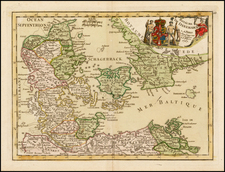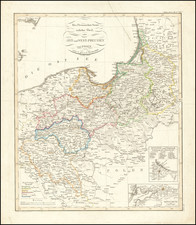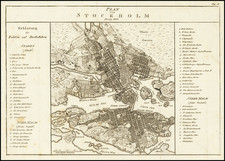Nice example of Braun & Hogenberg's map of Denmark, the first printed map of Denmark based upon Danish sources.
The map shows Denmark with Holstein and Zealand with Bornholm in the east. Decorated with three cartouches, the coat of arms of Denmark, two whales and a sailing boat. This is the first state, with the date in Roman numerals in the bottom right of the title cartouche. The date would be removed in later states.
Drawn by Marcus Jordan at the request of Duke Heinrich Rantzau, viceroy of Schleswig-Holstein. This map of Denmark is the only map which appeared in Braun & Hogenberg's landmark book of city views Civitates Orbis Terrarum, one of the most expensive and important books of the 16th Century. It is the only real geographical map in a work that is expressly intended as a city atlas. The editors offer it as an overview of the cities that are presented subsequently.
They include Denmark, Schleiswig-Holstein, Zelandia and the southern part of Sweden, which was part of Denmark until 1658. Drawn by Marcus Jordan, the map is dedicated to Count Heinrich von Rantzau the Danish governor in Schleswig-Holstein and includes his coat of arms flanked by Athena and Ares in the lower right-hand corner. Ranztau was an acquaintance of Georg Braun and provided him with a large number of documents with views of the northern cities.
This finely engraved map is embellished with sea monsters, a sailing ship, coat of arms and an allegorical scene suggesting Denmark's importance in exploration and military strength.
Georg Braun (1541-1622) was born and died in Cologne. His primary vocation was as Catholic cleric; he spent thirty-seven years as canon and dean at the church St. Maria ad Gradus, in Cologne. Braun was the chief editor of the Civitates orbis terrarum, the greatest book of town views ever published. His job entailed hiring artists, acquiring source material for the maps and views, and writing the text. In this role, he was assisted by Abraham Ortelius. Braun lived into his 80s, and he was the only member of the original team to witness the publication of the sixth volume in 1617.
Frans Hogenberg (ca. 1540-ca. 1590) was a Flemish and German engraver and mapmaker who also painted. He was born in Mechelen, south of Antwerp, the son of wood engraver and etcher Nicolas Hogenberg. Together with his father, brother (Remigius), uncle, and cousins, Frans was one member of a prominent artistic family in the Netherlands.
During the 1550s, Frans worked in Antwerp with the famous mapmaker Abraham Ortelius. There, he engraved the maps for Ortelius’ groundbreaking first atlas, published in Antwerp in 1570, along with Johannes van Deotecum and Ambrosius and Ferdinand Arsenius. It is suspected he engraved the title page as well. Later, Ortelius supported Hogenberg with information for a different project, the Civitates orbis terrarium (edited by Georg Braun, engraved by Hogenberg, published in six volumes, Cologne, 1572-1617). Hogenberg engraved the majority of the work’s 546 prospects and views.
It is possible that Frans spent some time in England while fleeing from religious persecution, but he was living and working in Cologne by 1580. That is the city where he died around 1590. In addition to his maps, he is known for his historical allegories and portraits. His brother, Remigius, also went on to some fame as an engraver, and he died around the same time as his brother.









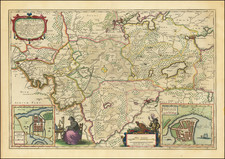
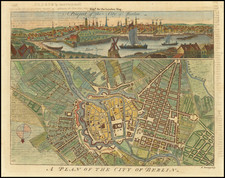
![[ Elfsborgs Chiefdom, Southwestern Sweden ] Karta öfver Elfsborgs Höfdingedöme. Utgivfven Af Firherre S. G. Hermelin. . . . Författad af Carl G. Forssell. 1808](https://storage.googleapis.com/raremaps/img/small/99084.jpg)
